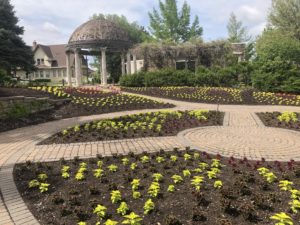By Kellyn Vuchetich
May 19, 2021
 Over the weekend, more than 60 volunteers helped install the annuals at Sunken Gardens for their Wake Up The Beds event. The installation will continue throughout the week as the weather allows. Designed by resident landscape horticulturists Steve Nosal and Alice Reed, this year’s “Ruby Slippers” theme harkens back to the original intent of the gardens when it was created in the midst of the Depression: to provide something beautiful to the city of Lincoln in uncertain times, and to remind the community that there’s no place like home. Red and yellow flowers now weave throughout the garden like ruby slippers on a yellow brick road.
Over the weekend, more than 60 volunteers helped install the annuals at Sunken Gardens for their Wake Up The Beds event. The installation will continue throughout the week as the weather allows. Designed by resident landscape horticulturists Steve Nosal and Alice Reed, this year’s “Ruby Slippers” theme harkens back to the original intent of the gardens when it was created in the midst of the Depression: to provide something beautiful to the city of Lincoln in uncertain times, and to remind the community that there’s no place like home. Red and yellow flowers now weave throughout the garden like ruby slippers on a yellow brick road.
Prior to the event I spoke with Steve Nosal, who gave me an overview of Sunken Garden’s fascinating history and provided insight on how he and Alice Reed developed this year’s theme.
Nosal traced Lincoln’s original love affair with gardens to Philip Edinburgh, the city’s first Parks director. The England-educated horticulturist was previously in charge of installing elaborate landscaping for the Omaha Trans-Mississippi Exposition in 1898. These over-the-top gardening designs included exotic plants and flowers that embellished the 184-acre Expo site with lush natural beauty. Edinburgh was soon hired to bring his expertise to the city of Lincoln.
The Lincoln Parks department held their first board meeting at the start of the 20th century at Edinburgh’s lead. Out of that meeting they decided to start planting gardens where they could: around schools, government buildings, and anywhere else with land to spare.
When the Depression came about, city commissioner Ernst Bair envisioned the initial plan for what would become the Sunken Gardens. “He came up with this idea of putting in a flower garden to give the people of Lincoln hope that the Depression was soon to be over with and beautified the city at the same time,” explains Nosal. “In fact we still use that concept today on the Sunken Gardens.”
 The city hired around 150 men for special projects meant to inspire the community, including the development of Pioneers Park in addition to this new flower garden. Bair chose a plot of land at 27th and Capital Parkway that had been donated in 1905 as the site for the garden. Floriculturist Fred Goebel and his son Henry were its first designers. By 1930, over 400 trees, a rose garden, and various other native perennials had been planted. Nosal notes that the heat at the bottom of the pit made it difficult for the early trees and shrubs to thrive, but the gardeners were committed to helping them grow despite the somewhat unfavorable conditions.
The city hired around 150 men for special projects meant to inspire the community, including the development of Pioneers Park in addition to this new flower garden. Bair chose a plot of land at 27th and Capital Parkway that had been donated in 1905 as the site for the garden. Floriculturist Fred Goebel and his son Henry were its first designers. By 1930, over 400 trees, a rose garden, and various other native perennials had been planted. Nosal notes that the heat at the bottom of the pit made it difficult for the early trees and shrubs to thrive, but the gardeners were committed to helping them grow despite the somewhat unfavorable conditions.
The garden was a success for many years, but around 1960 a massive flood filled the concave space, killing all existing trees and perennials. As a result, the gardeners at the time came up with the idea to start planting annuals.
Nosal and Reed started in the 1970’s and 1980’s, respectively, as the 3rd generation of gardeners at Sunken Gardens. Together they had the idea of assigning a different theme each year to the annual garden. “Back in the early days we were looking for ways to express designs, and we started to do themes, different color patterns, things like that,” says Nosal. “So that’s kind of how we evolved into what it is today. We’re always asking the citizens what they would like to see. Most of them are very in favor of what we do.”
The pair is responsible for the design and selection of plants for the annuals, a process that must be completed by November of each year, when orders are placed for the Spring. “The design this year is called Ruby Slippers, based on the movie The Wizard of Oz,” says Nosal. “The end of the movie she finds out there’s no place like home, and that’s what we try to exemplify Lincoln as we market it as a colorful artsy community. There’s no place like Lincoln.”
Although Nosal and Reed oversee much of what goes on at Sunken Gardens, it takes a village to run a garden. Others who contribute to its success include volunteer coordinators, greenhouse workers, interns, and a variety of gardeners who help with regular maintenance tasks such as weeding, mowing, tilling, and trimming.
Community members are also invited to help out in the garden through two volunteer programs that run throughout the summer. Garden Gab is a learn-and-do program where volunteers are taught seasonal gardening techniques and skills before then performing those tasks in the garden. The program takes place every Tuesday and Thursday from 9am-noon. The Docent program trains volunteers to welcome guests and provide tours to the public. The first Docent program training meeting will take place Tuesday, June 1 at 8am. Those interested in participating can RSVP to ZHalley@lincoln.ne.gov.

Over the weekend, more than 60 volunteers helped install the annuals at Sunken Gardens for their Wake Up The Beds event. The installation will continue throughout the week as the weather allows. Designed by resident landscape horticulturists Steve Nosal and Alice Reed, this year’s “Ruby Slippers” theme harkens back to the original intent of the gardens when it was created in the midst of the Depression: to provide something beautiful to the city of Lincoln in uncertain times, and to remind the community that there’s no place like home. Red and yellow flowers now weave throughout the garden like ruby slippers on a yellow brick road.
Prior to the event I spoke with Steve Nosal, who gave me an overview of Sunken Garden’s fascinating history and provided insight on how he and Alice Reed developed this year’s theme.
Nosal traced Lincoln’s original love affair with gardens to Philip Edinburgh, the city’s first Parks director. The England-educated horticulturist was previously in charge of installing elaborate landscaping for the Omaha Trans-Mississippi Exposition in 1898. These over-the-top gardening designs included exotic plants and flowers that embellished the 184-acre Expo site with lush natural beauty. Edinburgh was soon hired to bring his expertise to the city of Lincoln.
The Lincoln Parks department held their first board meeting at the start of the 20th century at Edinburgh’s lead. Out of that meeting they decided to start planting gardens where they could: around schools, government buildings, and anywhere else with land to spare.
When the Depression came about, city commissioner Ernst Bair envisioned the initial plan for what would become the Sunken Gardens. “He came up with this idea of putting in a flower garden to give the people of Lincoln hope that the Depression was soon to be over with and beautified the city at the same time,” explains Nosal. “In fact we still use that concept today on the Sunken Gardens.”

The city hired around 150 men for special projects meant to inspire the community, including the development of Pioneers Park in addition to this new flower garden. Bair chose a plot of land at 27th and Capital Parkway that had been donated in 1905 as the site for the garden. Floriculturist Fred Goebel and his son Henry were its first designers. By 1930, over 400 trees, a rose garden, and various other native perennials had been planted. Nosal notes that the heat at the bottom of the pit made it difficult for the early trees and shrubs to thrive, but the gardeners were committed to helping them grow despite the somewhat unfavorable conditions.
The garden was a success for many years, but around 1960 a massive flood filled the concave space, killing all existing trees and perennials. As a result, the gardeners at the time came up with the idea to start planting annuals.
Nosal and Reed started in the 1970’s and 1980’s, respectively, as the 3rd generation of gardeners at Sunken Gardens. Together they had the idea of assigning a different theme each year to the annual garden. “Back in the early days we were looking for ways to express designs, and we started to do themes, different color patterns, things like that,” says Nosal. “So that’s kind of how we evolved into what it is today. We’re always asking the citizens what they would like to see. Most of them are very in favor of what we do.”
The pair is responsible for the design and selection of plants for the annuals, a process that must be completed by November of each year, when orders are placed for the Spring. “The design this year is called Ruby Slippers, based on the movie The Wizard of Oz,” says Nosal. “The end of the movie she finds out there’s no place like home, and that’s what we try to exemplify Lincoln as we market it as a colorful artsy community. There’s no place like Lincoln.”
Although Nosal and Reed oversee much of what goes on at Sunken Gardens, it takes a village to run a garden. Others who contribute to its success include volunteer coordinators, greenhouse workers, interns, and a variety of gardeners who help with regular maintenance tasks such as weeding, mowing, tilling, and trimming.
Community members are also invited to help out in the garden through two volunteer programs that run throughout the summer. Garden Gab is a learn-and-do program where volunteers are taught seasonal gardening techniques and skills before then performing those tasks in the garden. The program takes place every Tuesday and Thursday from 9am-noon. The Docent program trains volunteers to welcome guests and provide tours to the public. The first Docent program training meeting will take place Tuesday, June 1 at 8am. Those interested in participating can RSVP to ZHalley@lincoln.ne.gov.
Kellyn Vuchetich is a journalism intern with KZUM.





